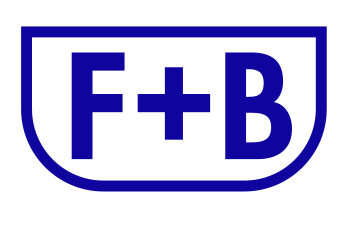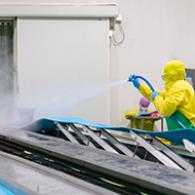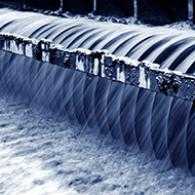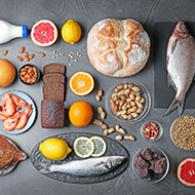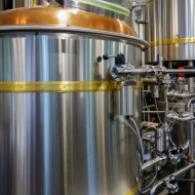Cleaning and disinfection in food and beverage production sites make sure the final product passes the required quality controls and is safe for the consumer.
At the beginning of each production shift, having a processing line free from residues that may impact on the end flavour, colour or texture sides is critical to maintaining the brand standard.
Even more important is to make sure that no undesired chemical residue, allergen, spoilage or pathogen bacteria, which might contaminate the end product, is present. Any negative impact on product integrity and brand protection are likely to affect the financial performance of the company as well as potentially harming consumer health.
Types of Cleaning in Food and Beverage Plants
There are two main types of cleaning methods: Automatic and Manual.
Automatic or semi-automatic cleaning and disinfection operations are those activities which are run by a pre-set system or machine; examples might be automatic cleaning in place (C.I.P.), membrane cleaning or bottle or crate washing.
It is important to validate that:
- The CIP system is completing the programs as intended
- Objects have been cleaned and sterilized properly
- Any residual chemicals have been removed
Monitoring activities should validate the key application parameters (time, temperature, concentration, flow, etc) and cleanliness/microbiological quality of the food contact surfaces measured via rapid techniques (ATP, protein-based tests, immune-enzymatic based lateral flow tests kits) and standard microbiological analysis.
Cross-checking these measurements during validation will result in good control over the application.
Manual based cleaning is carried out by typically performed operators making use of specific dosing systems or cleaning tools. Examples might be open plant cleaning (O.P.C.) with foaming systems on large surface areas or the manual cleaning of utensils, tools or machine parts.
In these applications, although the key application parameters remain very important, it is also crucial to make sure operators carry out their task consistently and effectively to meet the required standard as the whole effectiveness of the hygiene task is literally, in this case, in the hands of the operator who’s carrying it out.
As well as ensuring each operator is suitably trained for the tasks that they are performing, they should also understand the importance of how, by simply using senses, it is possible to prevent potential food safety incidents, or costly non-compliances, with subjective cleaning validation checks being completed throughout the cleaning process.
It is important to note that applying a disinfectant over an unclean surface makes the disinfection step ineffective. On top of wasting water, time, energy and chemical, the food contact surface may have microbial residues that could endanger the following production.
Post-cleaning Checks Should Include
Sight
Surfaces look simply clean; no shades of colours shall be present on a clean stainless steel surface. For example, a blue shade on a stainless-steel food contact surface might indicate fats not being correctly removed, a white shade might indicate the presence of a mixed organic as well as inorganic soil, while a yellow shade might indicate fats have not been correctly removed from that surface for some time
Smell
Surfaces and food and beverage production machines shall simply smell “clean”. Rancid odours might indicate that there are old residues not being correctly removed; lifting lids, conveyors or smelling the lower parts of frames or machines is a good way to make sure there is no old soil left
Touch
A stainless-steel food contact surface after cleaning shall not be greasy and by passing a finger on it there should not be any mark.
Cleaning operators should be checking the surfaces, machines or department they are assigned to every time by using their senses, and if applicable, rapid kits (ATP for example), before moving to the disinfection step. This activity should be recorded electronically to increase the operator’s feeling of responsibility for the task they are undertaking and to keep an auditable paper trail.
Pre-operational Inspections
Pre-operational inspections should be in place prior to starting up a food or beverage processing line
Typically in the food processing business, cleaning is done at the end of the shift, usually at evening/night and there may be several hours before production starts back. Just like the importance of checking on critical functions and systems before a plane takes off, pre-operational inspections should be in place prior to starting up a food or beverage processing line. In the time since the previous shift, the equipment will not only have gone through cleaning and disinfection procedures, but potentially also through maintenance repairs, and idle time.
The pre-operational inspection should allow a trigger for corrective actions: cleaning, for example, shall be re-done if the inspection result of a specific line or machine is negative before resuming the food production operations.
Regardless of how simple or complex an object is, there is always a chance that something could go wrong. What could be more important than verifying that an allergen cleaning has been properly conducted on a line? This is where a pre-operational checklist, asking the following questions, would be a significant benefit.
- Have all product contact areas been properly cleaned?
- Have all tools used for sanitation or maintenance been removed?
- Is all equipment that was dismantled for cleaning put back in place and properly aligned?
Download a Template to help with your Pre-operational Checks
THE TEMPLATE WILL BE EMAILED TO YOU - PLEASE CHECK YOUR SPAM FOLDER IF IT DOES NOT ARRIVE IMMEDIATELY.



